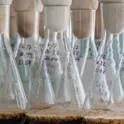More scrutiny needed for less-deadly foodborne bacteria
Foodborne pathogens in the Bacillus cereus group cause diarrhea and vomiting. Credit: Penn State. — by Penn State University, USA Employing advanced genetic-tracing techniques and sharing the data produced in real time could limit the spread of bacteria — Bacillus cereus — which cause foodborne illness, according to researchers who implemented whole-genome sequencing of a pathogen-outbreak investigation. “Here, in our study, we use this approach for the first time on Bacillus cereus,” said Jasna Kovac, assistant professor of food science, Penn State. “It is our hope that whole-genome sequencing of Bacillus will be done more often as a result of our research, as it allows us to differentiate between the various species of Bacillus cereus group and project the food-safety risk associated with them.” Characterization of Emetic and Diarrheal Bacillus cereusStrains From a 2016 Foodborne Outbreak Using Whole-Genome Sequencing: Addressing the Microbiological, Epidemiological, and Bioinformatic Challenges► Read original article► Download original article (pdf) Done in response to an outbreak of foodborne illness in upstate New York in 2016, the project marked the first time researchers conducted whole-genome sequencing to investigate a Bacillus cereus outbreak to link isolates from human clinical cases to food. The outbreak, which lasted less than a month, stemmed from contaminated refried beans served by a small Mexican […]














